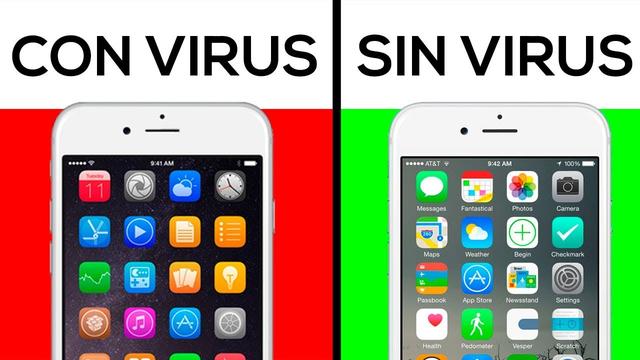iphone
Time: globisoftware
On: Feb/05/2023
Category: Huawei iphone samsung Digital life
Tags: My iPhone can get a virus
Discover if your iPhone has a virus and what do you have to do to eliminate the virus.We tell you all the options you have available to eliminate any virus from your iPhone
Porsara Piquer Martí, Macworld editor
Content
If your iPhone acts weird, it is very likely that you have a virus and then look for information on how to eliminate an iPhone virus.
Despite the urban legend that says that iPhone or iPad are not infected with viruses, unfortunately your iOS device can also be infected with malware, which is why you are interested to know how to eliminate a virus on iPhone or iPad, to be able to use againYour Apple device normally.
You may be the case that you think your iPhone is infected when, for example, you start seeing ads in unwanted places, or when you receive warnings in which you are recommended to download a specific application to clean your phone.
Whatever the case, if your iOS device has acquired an annoying virus or malware, you will be able to eliminate it.Keep reading to discover how.
Before continuing, we want to recommend our selection of better antivirus for Apple, in this way you can avoid seeing in this same situation in the future.
How to know if my iPhone has a virus
Technically speaking, a virus is a malicious coding type that is self-instead in another program, while a Trojan is a malware that you will initially see as a harmless program, but once you run it will infect your team.
There are many iOS applications that have suffered the insertion of malicious codes or even the "kidnapping" of developer tools.
Although applications with malware must be, in theory, captured in their approval stage before appearing in the App Store, many released phones can also install apps from other sources, and with it, install some malicious app.

iOS usually avoid malware attacks through a system that prevents the virus from accessing other applications and spreading to the underlying operating system.
If your iPhone or iPad does not seem to work normally, ask yourself the following questions:
If your iPhone or iPad acts strangely continuously, regardless of whether you access any concrete application or not, then it is surely due to a hardware problem.It is very unlikely that malware has penetrated the heart of the operating system.
Is it an application that causes problems on your iPhone or iPad?
As we explain lines above, instead of a virus, you have simply installed a problematic app.
This does not necessarily mean that it is an intentionally created app.
Because hackers have it very difficult to access an iOS device, one of their most common strategies is based on deciphering the development kit.In this way, hackers obtain the ability to redirect to websites of doubtful legitimacy every time you use the infected application.
If you think this is your case, we recommend that you take a look first to check if there are available updates of the application, since in the update the problem may have been solved and corrected.
Another advice is to visit the official website of the application or the developer's Twitter feed (if you have one), to see if it has officially informed about the problem.
If there are ways to contact application developers, do it.They may offer a solution, and in case they cannot, they can at least work on it.
In case the update does not solve the problem, uninstall the app.If the problem disappears, you will have found the culprit.
Here are a series of tips that can help make the virus disappear from your iPhone or iPad:
1.Delete history and data from your iPhone websites
This trick may help you solve the problem of continuously redirected to malicious web pages without your authorization.
Dirígete a ‘Ajustes > Safari > Borrarhistorial y datos de sitios web’.When you touch on ‘Delete’ you will eliminate history, cookies and other navigation data.
2.Turn off and reset your iPhone or iPad
Keep the ignition button pressed until the screen changes and the off sliding bar appears.Slide right to turn off the phone.
To reset the iPhone or iPad, press the ignition button again.Apple's logo will appear.Wait until the password application appears.
If you need more specific information on how to reset your iPhone or iPad click on the link.
3.Restore your iPhone to the last backup
If you make backup copies of your iPhone or iPad frequently, then it will be very easy to restore your iOS device to the last copy made.
If this fails, it means that the malware was already installed in that last copy you made.Restore an even older copy again.
If you are lucky you can find a backup that has been made prior to the date on which the malware was installed on your iPhone or iPad.
4.Your iPhone restores your factory values
If you do not find any malware free backup, then, it is best to start from scratch, that is, you restore your iPhone to its factory predetermined values.
Para ello, dirígete a ‘Ajustes > General > Restablecer >Borrar contenidos y ajustes’. Tendrás que ingresar tu contraseña para confirmar el proceso.Once completed, start your iPhone or iPad as a new device.
The next step will be to install the applications you use again and re -configure the device according to your preferences.
How to protect your malware iPhone
Update iOS regularly.We recommend that you do not do Jailbreak, and that if you do, be careful about the software you decide to install, and the sites from where you decide to download them.
Finally, you never open links of those that are not sure, many times those malicious links are a way to allow the entry of malware and viruses to your iOS devices.
